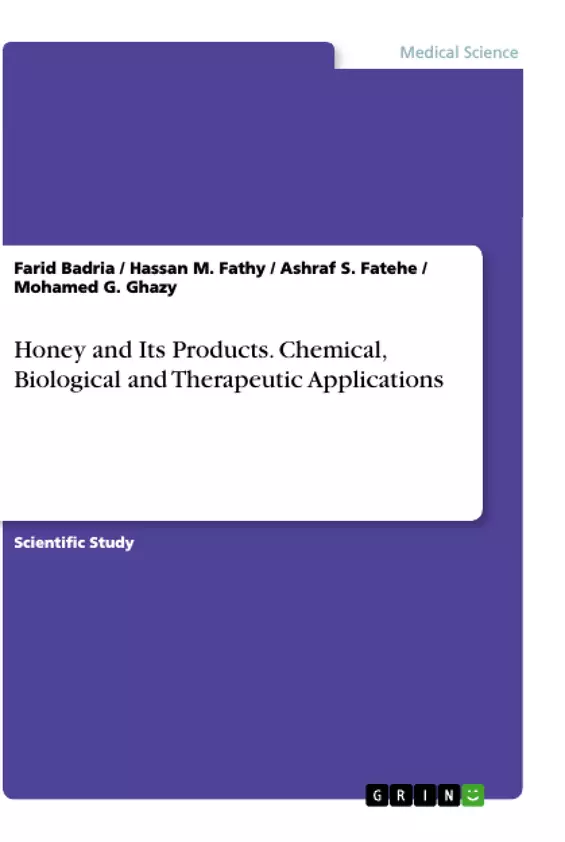The study includes measurement of bee activity in collecting and producing honey, propolis and bee venom according to bee race, in a comparative study between Carniolan hybrid and Italian hybrid. For one year and study of some biological and chemical properties of some bee products (Honey, propolis and bee venom) and their effects on three types of cancer cells (Hep-G2, Caco-2 and MCF-7) in a comparative study with the effort of two drugs (5Fu and Cis-pt) in different concentrations. The study dealt with the following points: 1. Activity honeybee in collecting and producing honey, propolis and bee venom according to bee race. 2. Biological properties of some bee products and their effects on some cancer cells. 3. Chemical properties of some bee products.
Apitherapy is the art and science of making therapeutic use of products of honey bee, including honey, bee pollen, propolis, royal jelly, bees wax and bee venom. apitherapy is defined as api, meaning bee and therapy from the greek word therapia, which literally means "curing" or "healing". apitherapy is healing by using bee products. hippocrates, the greek physician known as the "father of medicine", recognized the hialing virtues of bee venom for treating arthritis and other joint problems. Since the ancient egyptians, cultures across the ages have revered the honey bee for its healing powers. Integrative medical apitherapy is the application of bee products like honey, pollen, royal jelly and propolis in healing therapies. apitherapy is an ancient alternative healing modality dating back several thousand years and used by hippocrates, mentioned by plato, and others throughout our history.
Inhaltsverzeichnis (Table of Contents)
- I. Introduction
- II - REVIEW OF LITERATURE
- 2.1. Honeybee activity in collecting and producing some bee products:
- 2.2. Biological properties of some bee products :
- 2.3.Chemical properties and ATR-FTIR : .
- III- MATERIALS AND METHODS..
- 3.1. Measurements of bee activity:..
- 3.2. Biological assays
- 3.3 Chemical assays and ATR-FTIR.
- IV-RESULTS AND DISCUSSION..
- 4.1. Honeybee activity in collecting and producing some bee products:
- 4.3. Chemical properties and ATR-FTIR of some bee products
- VI-REFERENCES
- I. SUMMARY
Zielsetzung und Themenschwerpunkte (Objectives and Key Themes)
This investigation focuses on the activity of honeybees in collecting and producing honey, propolis, and bee venom, comparing the performance of Carniolan hybrid and Italian hybrid bee colonies. It also explores the biological and chemical properties of these bee products and their effects on various cancer cell lines.
- Bee activity in collecting and producing honey, propolis, and bee venom
- Comparison of bee colony performance based on race (Carniolan vs. Italian)
- Biological properties of honey, propolis, and bee venom
- Effects of bee products on cancer cells (Hep-G2, Caco-2, and MCF-7)
- Chemical properties and ATR-FTIR analysis of bee products
Zusammenfassung der Kapitel (Chapter Summaries)
- Introduction: This chapter provides a general overview of the study's goals and objectives, highlighting the importance of bee products and their potential applications in various fields, particularly in apitherapy.
- Review of Literature: This section presents a comprehensive review of existing research on honeybee activity, the biological and chemical properties of honey, propolis, and bee venom, and their potential therapeutic applications.
- Materials and Methods: This chapter describes the methodology used in the study, including the experimental design, bee colony management, data collection procedures, and analytical techniques employed to assess bee activity, biological properties, and chemical composition of the bee products.
- Results and Discussion: This chapter presents and discusses the findings of the study, focusing on the bee colony activity, biological effects of bee products on cancer cells, and chemical properties of the different bee products.
Schlüsselwörter (Keywords)
The study centers on apitherapy, honeybee activity, honey, propolis, bee venom, biological properties, chemical properties, ATR-FTIR, cancer cells, Hep-G2, Caco-2, MCF-7, 5Fu, Cis-pt, comparative study, bee race, Carniolan hybrid, Italian hybrid.
- Quote paper
- Farid Badria (Author), Hassan M. Fathy (Author), Ashraf S. Fatehe (Author), Mohamed G. Ghazy (Author), 2017, Honey and Its Products. Chemical, Biological and Therapeutic Applications, Munich, GRIN Verlag, https://www.grin.com/document/512415



